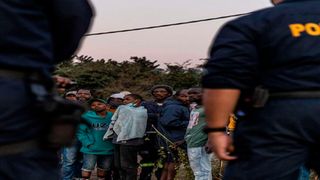
South African police officers in Durban on July 16, 2021.
| AFPWeekend
Premium
Requiem for a nation: Violence, literature and South Africa society
What you need to know:
- Chaos seems to be periodical in South African society and this has been aptly captured in South African literature.
- Country full of contradictions, where peace can be disrupted at any moment and where poverty lives side by side with riches.
South Africa soars in the hyperbolic cadences of opposing extremities: it can be consoling or disturbing, sacred or profane; it can be exhilarating, appealing and inspiring — or annoying, chilling and brazen.
It is a country of confounding realities: In one moment, the country is peaceful and the best place to be and, in the next moment, cars are ablaze, shops are being looted, and the country is tottering on the brink.
On July 7, 2021, Jacob Zuma, the former president of South Africa, was arrested for contempt of court and started serving a 15-month prison sentence. Chaos then ensued as protesters demanded his release. Crowds ransacked, looted and set ablaze shopping malls. They smashed cars and unleashed anarchy in the streets.
Chaos seems to be periodical in South African society and this has been aptly captured in South African literature. One of the best books on this is Can Themba’s Requiem for Sophiatown. Like South Africa, Sophiatown was a place of contradictions as described by Don Mattera as one that “also had its beauty; picturesque and intimate like most ghettoes... Mansions and quaint cottages... stood side by side with rusty wood-and-iron shacks, locked in a fraternal embrace of filth and felony... The rich and the poor, the exploiters and the exploited, all knitted together in a colourful fabric that ignored race or class structures.”
While the rest of South Africa was groaning under apartheid, Sophiatown was vibrant and defiant. Can Themba writes in Requiem for Sophiatown about how he used to enjoy a hangout called Mabeni’s: “... where the great Dolly Rathebe once sang the blues to me. I didn't ask her. She just sidled over to me on the couch and broke into song. It was delicious. But now Dolly is in Port Elizabeth, and Mabeni, God knows where. These are only highlights from the swarming, cacophonous, strutting, brawling, vibrating life of the Sophiatown that was."
Then for Sophiatown, luck simply ran out. The government sent bulldozers and razed it to the ground in February 1955. There were also 2,000 armed policemen who were involved to “peacefully” move Africans into the township of Meadowlands, a new area, as required by Apartheid laws. Sophiatown and the adjoining areas had been declared a dwelling place for white people and therefore Africans had to be moved to keep whites and Africans apart.
Story of defiance and defeat
Can Themba, who had spent the best years of his life in Sophiatown, also ran out of luck. He must have been so heartbroken that in Requiem for Sophiatown, the narrator says, “And still I wander among the ruins trying to find one or two of the shebeens that Dr. Verwoerd has overlooked. But I do not like the dead-eyes with which some of these ghost houses stare back at me. One of these days I, too, will get me out of here. Finish and clear!”
It is said that even after Sophiatown was reduced to rubble, some families continued living in the ruins as they couldn’t qualify for rehousing. And Can Themba’s narrator poignantly wanders among the ruins as if looking for lost things. This tendency to destroy things, sometimes at the slightest provocation, and to leave ruins behind is obviously worrying – and it has been witnessed not only in South Africa but also in Kenya and other countries.
“My fellow South Africans, I address you this evening with a heavy heart,” South African President Cyril Ramaphosa said in an address to the nation on July 12, 2021. He continued: “Over the past few days and nights, there have been acts of public violence of a kind rarely seen in the history of our democracy. Property has been vandalised and destroyed. Shops have been looted. Law-abiding citizens have been threatened and intimidated. Workers are scared that they may not be able to return to work. People have died.”
The speech was like a requiem for Sophiatown with its story of defiance and defeat. Alan Paton, in Cry, the Beloved Country, a requiem of his own for his country of South Africa, wrote that, “Cry, the beloved country, for the unborn child that’s the inheritor of our fear. Let him not love the earth too deeply. Let him not laugh too gladly when the water runs through his fingers, nor stand too silent when the setting sun makes red the veld (grassland) with fire. Let him not be too moved when the birds of his land are singing. Nor give too much of his heart to a mountain or a valley. For fear will rob him if he gives too much.”
Like in many African countries, many South Africans live in poverty. There is a lot of inequality and this sometimes breeds anger. Though the arrest of former president Jacob Zuma could have triggered the riots, opportunists seem to have also taken over. This is a worrying trend not only in South Africa but also in Kenya, where even mild protests quickly turn into mayhem and looting.
Kenya can learn a few lessons from South Africa. It will be good for the political leadership to listen to the issues citizens have so that some of them are addressed before Kenya heads to the general election in 2022. Peaceful co-existence requires some work from both government and individuals working towards a united nation.





